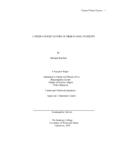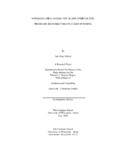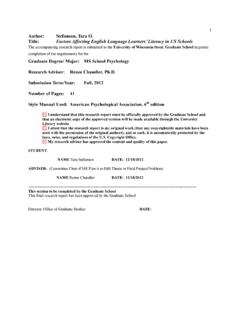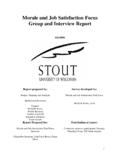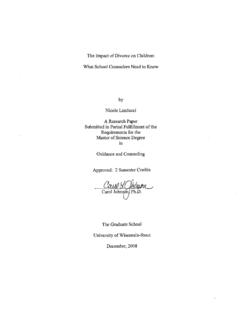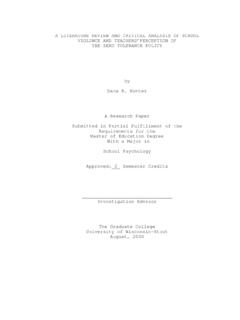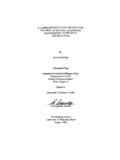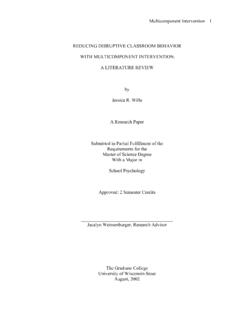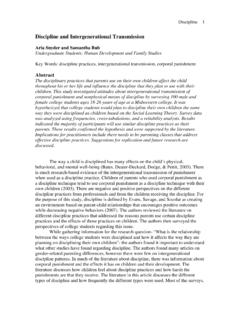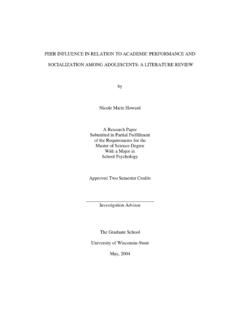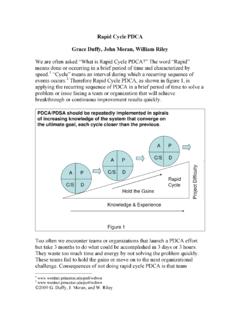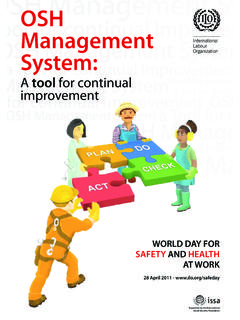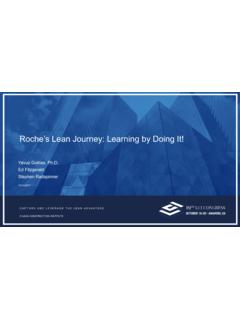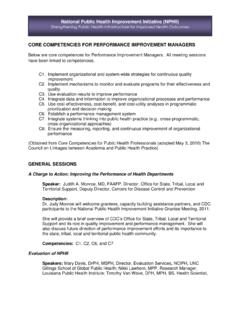Transcription of Implementing the 5S Methodology for Lab Management
1 Implementing the 5S Methodology for Lab Management In the Quality Assurance Lab of a Flexible Packaging Converter by Ameya Chitre A Research Paper Submitted in Partial Fulfillment of the Requirements for the Master of Science Degree m Technology Management A proved: 2 ~ Credits L The Graduate School University of Wisconsin-Stout December, 2010 1 Author: Title: The Graduate School University of Wisconsin-Stout Menomonie, WI Chitre, Ameya R. Implementing 5S Methodology for Lab Management In the Quality Assurance Lab of a Flexible Packaging Converter Graduate Degree/ Major: MS Technology Management Research Adviser: Dr. James Tenorio, MonthlYear: December, 2010 N umber of Pages: 50 Style Manual Used: American Psychological Association, 6th edition Abstract 5S is a Japanese Methodology to organize and improve the efficiency of a shared workspace by incorporating seemingly regular tasks such as cleaning, sorting, and re-arranging the surroundings and method of operation within the workspace.
2 5S consists of five phases or activities with names starting with the letter S, and provides a basic foundation for any organization's Lean initiative for continuous improvement. This paper documents a project undertaken by the author to implement 5S in the quality assurance lab of a flexible packaging converter. The study focused on Implementing 5S 2 activities in the targeted work area and documents results in form of photographs. The study also assesses its own approach, recommends alternative strategies for this project in the future and makes recommendations for expanding the scope of this exercise to other areas of the company and serves as a platform for achieving tangible and quantifiable gains in productivity.
3 The Graduate School University of Wisconsin Stout Menomonie, WI Acknowledgments I would like to thank Dr. James Tenorio for his support as my advisor for this study. I also thank University of Wisconsin-Stout for giving me an opportunity to pursue graduate studies. This paper would not have been possible without the encouragement and support of Jason Vandeloo and Matt Budahn at Belmark, and the people at Pearson who provided me actual project materials to better understand the scope of such projects. 3 I would like to dedicate this effort to my grandparents for being my unquestioning fans all my life. I am thankful to my parents for instilling the value of education and hard work within me, and their constant encouragement in my endeavors.
4 I thank my uncle Tushar and aunt Radhika for simply being there. Finally, all my friends whom I did not mention in person please know that you have my deepest appreciation. Ameya Chitre 4 Table of Contents Abstract .. 2 List of Figures .. 6 Chapter I: Introduction .. 7 Statement of the Problem .. 7 Purpose of the Study .. 8 Definition of Terms .. 8 Limitations of the Study .. 13 Chapter II: Literature Review .. 14 Lean Manufacturing .. 14 The Practice of SS .. IS SS: Misconceptions and Perceptions .. 16 Lean and SS in graphic communications .. 18 Starting the SS process .. 19 Chapter III: Methodology .. 24 Identifying the Problem .. 24 Photographs .. 24 Limitations .. 24 Method .. 2S Chapter IV: Results.
5 31 Item Analysis .. 31 Red Tagging .. 32 5 Cleanliness .. 33 Visual Workplace .. 35 Organization .. 36 Chapter V: Discussion .. 38 Limitations .. ; .. 38 Observations and Recommendations .. 39 Conclusions .. 42 References .. 43 Appendix A: Example for Red Tag Template .. 45 Appendix B: Example for Standard Work Procedure Template ..46 Appendix C: Example for Lean Event Scope Sheet Template ..47 Appendix D: Pictorial representation of stages of 5S .. 48 6 List of Figures Figure 1: Red Tagged Items of unknown utility value .. 32 Figure 2: Red Tagged Items of known utility value .. 33 Figure 3: Unclean equipment.. 34 Figure 4: Clean equipment.. , .. 34 Figure 5: Unidentified lab equipment.
6 35 Figure 6: Clearly identified lab .. 36 Figure 7: Uneconomical utilization of storage space .. 37 Figure 8: Economical utilization of storage space .. '" .. 37 7 Chapter I: Introduction 5S is a Methodology for organizing a shared workspace such as a production floor. It is a component of lean manufacturing and philosophy for managing a work place or workflow with the intention of improving efficiency, eliminating waste, and increasing process consistency. It derives its name from the use of five Japanese words beginning with the letter S as the cornerstones of this philosophy. These words are: "Seiri" meaning Sort, "Seiton" meaning Set in Order, "Seiso" which implies Shining or Cleanliness, "Seiketsu" which means Standardize, and "Shitsuke" which implies Sustaining.
7 Belmark Inc. is a leading packaging manufacturer/converter based in De Pere, WI with an additional facility in Phoenix, AZ. Belmark consists of three business units - Pressure Sensitive Labels, Flexible Films and Folded Cartons. Belmark's technical competency includes a dedicated Research & Development team, a dedicated Quality Assurance (QA) team, in-line flexography printing, laminating, as well as a full-fledged graphics team and digital printing. Belmark's QA team is responsible for collecting run samples during production and testing these samples. Belmark's QA lab is fully equipped to perfonn tests such as Gas Chromatography, Tensile testing/Peel testing, Coefficient of Friction testing, and Heat Seal Profile testing.
8 Statement of the Problem Although the QA lab appears to be extremely neat and clean, there is room for improvement. The current arrangement of testing equipment and apparatus used on the testing equipment does not always provide efficiency of motion. Clear identification of the lab equipment and apparatus could also be implemented. Moderately high amount of cleanliness and regular cleaning can be useful for this laboratory. 8 Purpose of the Study The purpose of this study was to work with QA technicians and the Quality Process Manager to identify the areas for improvement in laboratory Management . It aimed to apply the philosophy of 5S to organize, clean and manage the labs thus improving efficiency of movement and work.
9 Definition of Terms 5S. A philosophy based on five Japanese terms utilized to create a workplace suited for visual control and lean production. Acetate. Clear plastic sheeting used to prepare overlays or used as a base for stripping films. Caliper. An instrument that measures the thickness; the thickness of a sheet of paper or other material measured under the specific conditions. Continuous Improvement. The ongoing improvement of products, services or processes through incremental and breakthrough steps; process of business Management based on data tied to customer satisfaction. Corrective Action. Implementing a solution resulting in the elimination or reduction of a known problem.
10 Coefficient of Friction. A scientific test performed to find out the minimal force required to move a two sheets or layers of material in contact with each other. Densitometer. An instrument used for measuring the optical density of a positive, negative or printed sheet. Downtime. The period of time in which a device is not working because the system is malfunctioning or under maintenance. Estimating. The process of determining approximate costs, required quality and quantity, and projecting waste. 9 Film. Sheets of flexible translucent or transparent acetate, vinyl, or other plastic base materials that are coated with a photographic emulsion; any thin, organic, non-fibrous flexible material (usually not more than inches thick) that is used as substrate in flexography.
